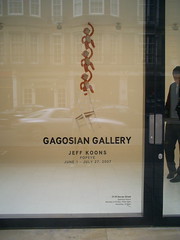Friday: I figured as I was going into town to meet Yol anyway (combined with the guilt of having a weekly travelcard that hadn't been used enough) I went down Davies Street (by Bond Street) to the Gagosian's central London haunt to see one half of the current Jeff Koons show. I used to really like the old site, just round the corner from Sadie Coles HQ. It was a great space, big upstairs with a smaller more intimate space in the basement, the whole thing tucked away off Regent Street.
Davies Street is completely different, not so much a gallery as a shop window, albeit a very swanky Bond Street affair with a black suited bouncer and no signs of the usual gallery paraphernalia: posh bird dressed in a black cocktail dress IMing her mates on last years iMac, answering phone with posh voice (that's what she's there for) and shuffling expensive catalogues around while owner patronises some weirdly dressed Eurotrash millionaire in pointy shoes. Here, the office is hidden behind a concealed door and from what I could see not much happens back there.
I liked it, I like the idea of being able to see the whole show without entering the gallery, I particularly like the idea of spotting the piece you need for your Paris/London/New York/LA home while heading up to Claridges for cocktails (of course you'll be in your chauffered Lexus/Merc/Beemer so the work had better be BIG so you can see it at speed through tinted glass - somehow I find it more honest.
But onto the work...
I really liked the work. I've always liked Jeff Koons, or at least the idea of Koons. There's always been something relentlessly anti-art in his work and the modes of production. These are pieces untouched by the artist or any kind of gestural idea of art that dominates the western tradition. It's like Duchamp without the irony or the cleverness, art stripped of its artiness but packed full of artifice. Looking at the work becomes a game of wondering what they're made of (aluminium in this case) which is much more interesting than looking at a Damien Hirst and wondering why he bothered. They're very tactile pieces - you want to touch them to see what they're made off (as I mentioned) but also to see if they're heavy or hollow, hard or soft and how they're coloured so convincingly (they do look like inflatable rubber). Strangely it's not that different to looking at a Bonnard or Monet, Manet or Velasquez in that there is a sense of seeing something that has been pulled out of nothing, an image in their case (and an idea in Koons;) that is vibrant and engaging but decidedly not real.
Lobster pic here.
